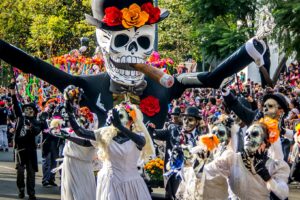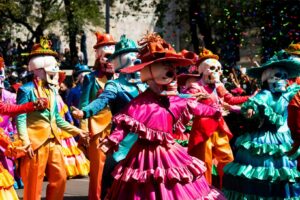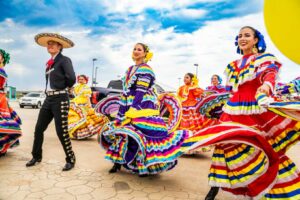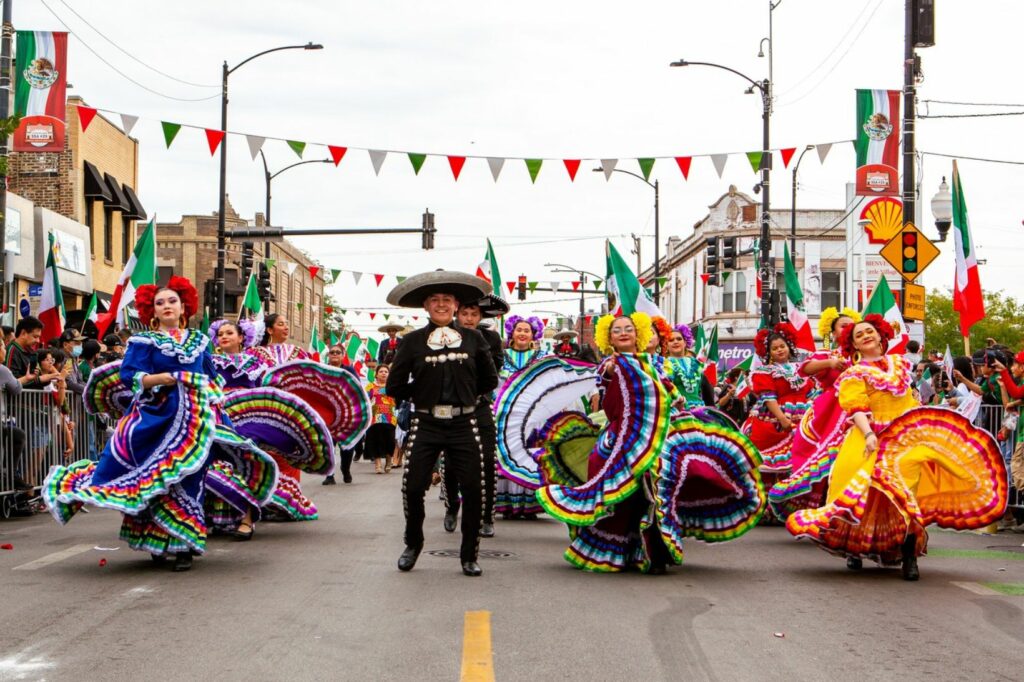Mexico’s vibrant culture is a tapestry woven with colorful festivals and lively celebrations that captivate the heart and soul. From the bustling streets of Mexico City to the serene villages in Oaxaca, these events reflect the nation’s rich history, diverse traditions, and deep-rooted sense of community. Mexican festivals offer a unique glimpse into the country’s spirit, where ancient customs blend seamlessly with modern influences.
Each celebration brings its own distinct flavor, whether it’s the exuberant parades of Día de los Muertos or the rhythmic beats of the Guelaguetza. These events are more than just spectacles; they’re a testament to Mexico’s enduring cultural heritage. As locals and visitors alike gather to honor their ancestors, indulge in traditional cuisine, and dance to infectious music, they become part of a shared experience that transcends borders and time. Mexican festivals and celebrations promise an unforgettable journey into a world of joy and tradition.
Mexican Festivals And Celebrations
 Mexican festivals and celebrations play a vital role in preserving the nation’s cultural identity. They provide an opportunity for communities to come together, fostering unity and pride among participants. These events often feature traditional music, dance, and attire, which help keep ancient customs alive.
Mexican festivals and celebrations play a vital role in preserving the nation’s cultural identity. They provide an opportunity for communities to come together, fostering unity and pride among participants. These events often feature traditional music, dance, and attire, which help keep ancient customs alive.
Celebrations like Día de los Muertos, observed every November 1st and 2nd, honor deceased loved ones by combining indigenous beliefs with Catholic traditions. This festival not only serves as a spiritual occasion but also highlights the syncretic nature of Mexican culture. Similarly, the Guelaguetza in Oaxaca showcases community cooperation, with participants exchanging gifts and sharing dances native to the region.
Dia De Los Muertos: The Day Of The Dead
Dia De Los Muertos, celebrated from October 31 to November 2, honors deceased loved ones with festive gatherings. This Mexican tradition merges indigenous and Catholic elements, reflecting a vibrant cultural heritage.
Symbolism And Traditions
 Families create altars, or “ofrendas,” adorned with photos, marigold flowers, candles, and sugar skulls to welcome spirits. These altars often contain the deceased’s favorite foods and drinks, signifying hospitality. Marigolds, known as “cempasúchil,” symbolize the fragility of life, guiding souls with their vivid color and aroma. Celebrants dress as skeletons, known as “calacas,” using face paint to represent the lifelike qualities of death, an integral aspect of the holiday.
Families create altars, or “ofrendas,” adorned with photos, marigold flowers, candles, and sugar skulls to welcome spirits. These altars often contain the deceased’s favorite foods and drinks, signifying hospitality. Marigolds, known as “cempasúchil,” symbolize the fragility of life, guiding souls with their vivid color and aroma. Celebrants dress as skeletons, known as “calacas,” using face paint to represent the lifelike qualities of death, an integral aspect of the holiday.
Cinco De Mayo: Its History And Meaning
Cinco de Mayo, widely celebrated in the US, commemorates Mexico’s victory at the Battle of Puebla. This day highlights resilience and cultural pride for Mexicans and Mexican-Americans.
The Battle Of Puebla
The Battle of Puebla took place on May 5, 1862, during the Franco-Mexican War. Mexico, under General Ignacio Zaragoza, defeated a well-equipped French army, despite being outnumbered. This unexpected victory bolstered Mexican morale and hindered France’s advances in Latin America, showcasing Mexico’s tenacity and strategic prowess against foreign invasion.
Dia De La Independencia: Mexican Independence Day
Dia de la Independencia on September 16 marks Mexico’s liberation from Spanish rule in 1810. It’s a pivotal celebration in the nation’s history, combining patriotism with cultural festivities.
Key Events And Festivities
 The celebration of Mexican Independence Day begins with the “Grito de Dolores.” The President of Mexico echoes the historical call for freedom from the National Palace balcony in Mexico City on the eve of the holiday, September 15. This symbolic act is mirrored in cities and towns across the nation, where local leaders deliver the cry amidst cheering crowds.
The celebration of Mexican Independence Day begins with the “Grito de Dolores.” The President of Mexico echoes the historical call for freedom from the National Palace balcony in Mexico City on the eve of the holiday, September 15. This symbolic act is mirrored in cities and towns across the nation, where local leaders deliver the cry amidst cheering crowds.
Fiesta De La Candelaria
Fiesta De La Candelaria is celebrated on February 2 in Mexico, marking the end of the Christmas season. This vibrant festival honors the Virgin of Candelaria, blending indigenous traditions with Catholic rites.
Unique Practices
Participants engage in customary candle-lit processions to express devotion. Families gather in homes to dress figures of the Baby Jesus in new garments, symbolizing purity and innocence. Traditional foods feature prominently, especially tamales, as a culinary highlight of the celebration. The festival further includes blessings of seeds and candles, merging agricultural cycles with religious observances.
Colorful Gatherings
 Mexican festivals and celebrations are a vibrant tapestry of history and culture that captivate both locals and visitors alike. They offer a unique glimpse into the nation’s soul, where ancient traditions and modern influences seamlessly intertwine. These events not only honor Mexico’s rich heritage but also foster community spirit and economic growth. As these festivals continue to gain international recognition, they serve as powerful ambassadors of Mexican culture, ensuring that the country’s diverse traditions are celebrated and preserved for future generations.
Mexican festivals and celebrations are a vibrant tapestry of history and culture that captivate both locals and visitors alike. They offer a unique glimpse into the nation’s soul, where ancient traditions and modern influences seamlessly intertwine. These events not only honor Mexico’s rich heritage but also foster community spirit and economic growth. As these festivals continue to gain international recognition, they serve as powerful ambassadors of Mexican culture, ensuring that the country’s diverse traditions are celebrated and preserved for future generations.

